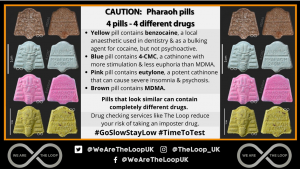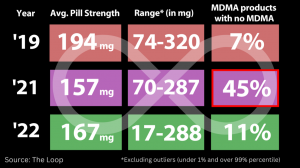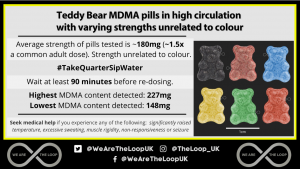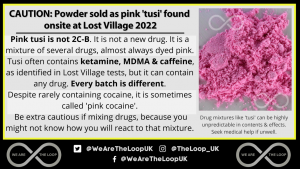Introduction:
This summer, The Loop’s wonderful team of chemists, health professionals, researchers and press officers has been busy delivering harm reduction services at festivals up and down the country in order to promote safety onsite, issue drug alerts where relevant, and help to build knowledge of the UK drugs market amongst festival-goers, stakeholders and support services.
3,4-Methylenedioxymethamphetamine, commonly referred to as MDMA or ecstasy, is a central nervous system stimulant and ‘party drug’ which is taken by a significant proportion of clubbers and festival-goers. In 2021, The Loop found an extraordinary rise in ‘imposter’ drugs being sold as MDMA, with the majority of missold MDMA turning out to be caffeine or part of a family of stimulant drugs called cathinones. We also identified a general decrease in the average strength of MDMA pills, echoing the findings of drug checking services across Europe (Vrolijk et al., 2022).
This year, we found far fewer ‘imposter’ drugs being missold as MDMA, and the market has returned to a not dissimilar position to where it was in 2019. While the strength of pills has increased somewhat from 2021, they are still notably lower strength than they were in 2017-9 when pills were regularly over 250mg MDMA in strength, two to three times a common adult dose.
It would be easy to read this and conclude that these trends will lead to a reduction in MDMA-related harm. While this may turn out to be the case, the risk of drug-related harm comes from many factors, and adulterated drugs are only a small constituent part of this. Patterns of drug consumer behaviour, wider societal factors and the response of events and organisations all contribute to the possibility of drug-related harm.
Comparing MDMA markets in recent years:
Last summer, The Loop found that there was significant disruption to the UK MDMA market during and after the Covid-19 pandemic.
Prior to the pandemic, the MDMA market in 2019 could be characterised by over nine in ten products sold as MDMA containing MDMA, many pills were high strength and often contained two to three times a common adult dose, and crystal was generally high purity. Last summer however, the market was turned on its head by Covid-19, lockdowns, Brexit and then the sudden reopening of UK nightlife venues on ‘Freedom Day’ after a closure of 16 months. Nearly half (45%) of MDMA products were found to contain no MDMA.
The main imposter drugs missold as MDMA were caffeine and cathinones. Over one fifth (21%) of expected MDMA samples turned out to be caffeine and nearly another fifth (19%) were cathinones. The caffeine was notable; carefully crafted crystals which were visually virtually identical to MDMA crystals and never seen previously by the Loop team. Of the samples which contained cathinones, 56% contained 4-CMC, 22% contained 3-MMC, 18% contained eutylone and 4% contained other cathinones. 4-CMC and 3-MMC were both imposter drugs new to being missold as MDMA in the UK market and notable last summer for both being legal to buy and sell in the Netherlands at that time.
Cathinones are generally more stimulating and less empathogenic than MDMA, leading to concerns that consumers may accidentally take too much because they were seeking an effect from the drug which it could not provide. The enhanced risk, therefore, comes from the potential for erroneous redosing by drug users who think they have purchased low purity MDMA rather than high purity cathinones.
Not all cathinones have equal risk profiles, however. Eutylone and N-ethylpentylone in particular are high risk cathinones when missold as MDMA, as they can cause a long period of agitation and insomnia after consumption which sometimes leads to anxiety and even psychotic episodes. This led to The Loop publishing care sheets, for N-ethylpentylone in 2018 and 2019, and 4-CMC and eutylone in 2021, to help people understand the effects of these drugs and how to manage them if someone they knew consumed them inadvertently.
The strength of MDMA pills tested by The Loop in the UK decreased between 2019 and 2021, dropping by an average of 37 milligrams, from 194mg to 157mg. Perhaps even more relevant in the context of drug related harm, we tested no pills with MDMA content over 300mg in 2021 or 2022.
In 2019, 4% of pills tested by The Loop contained 300+mg MDMA. Fewer super strength pills is highly likely to lead to less drug-related harm, as MDMA toxicity caused by high strength pills and high purity crystal has been one of the main factors behind the large increase in MDMA-related deaths in recent years. MDMA pills contained an average of 20mg of MDMA in the UK in 2010, with 8 MDMA-related deaths recorded, rising to a peak of 190mg of MDMA in 2019. 2018 saw the highest number of MDMA-related deaths on record, when 92 deaths were recorded, nearly 30% of whom were under the age of 20.
Disruption to the UK MDMA market perhaps was best illustrated by the Pharaoh alert issued by The Loop towards the close of the foreshortened 2021 summer festival season.
Four pills were tested in the Loop lab on the same day at the same festival, all having a visually almost identical shape or pressing, yet only one of them contained MDMA. Two of the others contained cathinones and the other contained benzocaine, a substance more usually used as a bulking agent for cocaine.
There are a number of different reasons put forward for the disruption to the UK MDMA market, including Brexit, the Covid-19 pandemic, lockdowns and a sudden surge in demand after ‘Freedom Day’ in July 2021, along with international restrictions on precursor chemicals and more lenient controls on cathinones in neighbouring countries.
The Loop’s MDMA findings in 2022:
The Loop’s overall impression of the 2022 summer festival season has been that the UK MDMA market has largely stabilised, with considerably fewer imposter drugs than seen the previoussummer. Average pill strength has remained at lower levels than in 2019, however, a finding echoed amongst drug checking services across Europe (Vrolijk et al., 2022).
The Loop found that 11% of MDMA products tested this summer contained no MDMA and instead contained some of the cathinones first seen last year, such as 4-CMC, and a few samples of caffeine. The main imposter drugs The Loop has issued alerts for have been chloroquine, 4-CMC and n-ethylpentylone.
Average ecstasy pill strength in the 2022 festival season was still lower than 2019 levels, with an average pill strength of 167mg, which some observers might presume would then lead to a reduction in MDMA-related deaths. There was considerable variation within this, however, with pills in circulation this year sometimes containing two to three times a common adult dose. As an example of this, The Loop issued an alert for Ninja Turtle pills which contained 280mg of MDMA.
With fewer missold and high strength drugs in circulation, The Loop has used this summer to draw people’s attention to the wide variations in pill strength. Variations in the strength of drugs in circulation can increase risk to drug users because they might consume lower strength pills and recalibrate their usual dose to the presumed lower strength by consuming larger quantities and then, if they take a batch with an unexpectedly higher strength variant of the same drug, they may unintentionally take a higher dose than anticipated and come to harm.
This was illustrated in the alert published by The Loop (below), where there were a number of Teddy Bear pills which were widespread in 2022, in different colours and strengths, ranging from 150mg to 250mg of MDMA. The variations in strength did not correspond to the different colours and therefore they were an additional cause for concern for people attempting to dose moderately but unaware of these discrepancies.
It would be easy to presume from this that The Loop’s 2022 findings indicate that there will be a reduction in harm from MDMA. This may prove to be the case, but the content and strength of illicit drugs is only one part of the picture of how people come to harm from taking drugs.
The wider picture of drug-related harm
When an MDMA-related death occurs and is brought to popular attention in the media, the common response is to see stakeholders and commentators, such as the police, parents or concerned members of the public, warn about a ‘bad batch’ of MDMA, which people are advised not to take. While this may be communicated with the best intentions, the evidence suggests that most UK MDMA-related deaths emerge not from ‘bad batches’ but from people accidentally poisoning themselves, by consuming unexpectedly large doses in adverse environmental conditions.
Taking larger doses (120mg+) of MDMA is associated with users having more adverse effects and those who die from MDMA poisoning tend to have high concentrations of MDMA in their blood. If a pill contains 270mg of MDMA, then the risk of someone coming to serious harm if they consume half a pill is possible but unlikely. If the same person consumes two or three pills, however, the risk is considerably higher and potentially fatal. If people are aware of the strength of what they are taking and adapt their behaviours to calculate dose correctly, then the risk of harm can be minimised.
Thus the ‘bad batch’ narrative of drugs is problematic because the dose is what makes the poison and a batch of pills, if consumed in halves or quarters, could be seen as a ‘good batch’ by some drug users. However, when people double drop or engage in other higher risk drug-taking behaviours the risk of harm increases greatly.
The challenge is that firstly, people simply don’t know how strong each pill is unless it is tested accurately, rapidly and locally, and the information is disseminated promptly to appropriate drug-using communities. Secondly, most people see one pill as one dose intuitively, as happens with many pharmaceutical medications. The Loop has worked hard with its audiences over the years to challenge this misunderstanding and to promote one quarter or one half of pill being a potentially risk-minimising dose, depending on strength.
This is why The Loop’s harm reduction campaigns convey messages such as #GoSlowStayLow, #TakeQuarterSipWater and #CrushDabWait. Thirdly, on a practical note, small hard pills can be almost impossible to break accurately into halves or quarters without equipment (as The Loop chemists can testify), and this is even more challenging when trying to avoid the scrutiny of security staff in a venue whilst attempting to do so. Accurate dosing might be desirable and desired, therefore, but physically impossible when involving the covert consumption of illicit substances.
However, MDMA dosage is just one part of the picture of how drug-related harm emerges. There are many other factors which influence someone’s risk of coming to harm from MDMA, such as their age, body weight, gender and menstrual cycle, underlying health conditions, use of prescribed medications, water consumption levels, levels of physical activity while intoxicated, how quickly they seek medical help if having an adverse reaction, health literacy and understanding of harm reduction approaches. In addition to these, perhaps the two main factors which contribute to MDMA-related deaths in the UK are polydrug use and the environment in which the drug is consumed.
Polydrug use is one of the main factors which contributes to drug-related harm, with most drug-related deaths in the UK involving more than one drug. For example, in Scotland 93% of drug deaths involved more than one substance in 2021. MDMA use can pose additional risk of harm when combined with alcohol, ketamine or stimulants such as cocaine or amphetamines.
Polydrug use like this is very common amongst people who attend UK music festivals, with The Loop’s annual English Festival Survey finding that 26.4% of festival-goers reported past year polydrug use in 2019 (defined as consumption of two or more illegal drugs) and drug-using festival-goers reported having taken an average of 2.6 illegal drugs in the last month (Measham and Simmons, 2022). In addition to these more common cases of polydrug use, MDMA use is extremely dangerous when combined with certain serotonergic drugs such as tramadol (a commonly prescribed opioid painkiller), dextromethorphan (a dissociative and ingredient in some cough syrups) and MAOI’s (found in some herbal supplements as well as ayahuasca / pharmahuasca).
One substance tested which was of particular concern this summer was a sample of “tusi” or “pink cocaine” tested at Lost Village festival. This powder is highly likely to contain neither 2C-B nor cocaine, and commonly contains a mixture of MDMA, ketamine, caffeine and sometimes other substances. It emerged in South America a decade or so ago and has been increasingly found across Europe in recent years. The main risk posed by this mixture of substances is that people do not know what they are taking and thus are engaging in polydrug use but with little knowledge of the combinations of drugs involved or their doses.
Environmental factors
Another key factor which affects the likelihood of someone coming to harm is the environment in which the drug is consumed. In the case of opioids, we know that people are much more likely to die when they take heroin alone than if they consume the drug in an overdose prevention centre.
One of the main effects of MDMA is that it increases body temperature, which can rise to dangerous levels, with the risk enhanced further when the person is dehydrated. The body’s ability to regulate temperature is not just affected by drug consumption, however, but by the physical environment in which the drug is taken.
The last few summers have seen temperatures at UK festivals regularly exceed 30 degrees and even 35 degrees this year. High temperatures pose a risk of people being more likely to succumb to harm from overheating, and it also means it is more likely that people will become severely dehydrated which compounds the risk of someone overheating while on MDMA.
Provision of chilled chill-out spaces, shaded seated areas and most importantly, plentiful free cool drinking water across sites are vital to the health and wellbeing of nightlife and festival customers, in order to show a commitment to the spirit as well as the letter of the law of the 2010 Mandatory Conditions which oblige all UK licensed premises to provide drinking water.
Conclusion
Changes in the UK drug market will affect the level of risk associated with drug use and undoubtedly have effects on how many people come to harm. The Loop’s findings from the summer of 2022 present a tentatively optimistic post-pandemic picture of the UK MDMA market having restabilised after the turmoil of the previous two years, with less ‘imposter drugs’ being sold and fewer high strength pills.
This is only part of the picture, however, and continued MDMA fatalities at UK music festivals this summer and nightclubs this autumn show that drug-related harm remains a concern.
Drug testing services, both publicly accessible and non-publicly accessible, can be important public health interventions on the individual level and at a wider societal level, if aspiring to reduce drug-related harm. Informing people of the contenta nd strength of substances of concern allows them to adapt their behaviours and take action to reduce risk.
Test results are additionally effective, however, if accompanied by advice and information about other factors that contribute to the reduction of drug-related harm and the enhancement of health and wellbeing, which is why The Loop endorses the added value of publicly accessible drug checking over and above non-publicly accessible drug testing. When providing healthcare consultations to individual members of the public, only part of the consultation involves discussing test results, and much more of the discussion involves talking to the individual about their broader drug-taking and associated behaviours and identifying any factors which could put them at additional risk.
When The Loop issues drug alerts and produces harm reduction content, the materials are informed as much by our health professionals and criminologists as our chemists, in order to draw the public’s attention to wider factors which contribute to drug-related harm, wider trends in the UK drug market and the steps which can be taken to reduce their level of risk.
Knowledge of the UK MDMA market is important but operates best as a springboard to inform wider discussions on drug-related harm.
This piece was written Fiona Measham, Chair in Criminology, University of Liverpool and member of The Loop senior team, and Adam Waugh, member of The Loop senior team. Tweets @Fmeasham and @adamwaughUK




